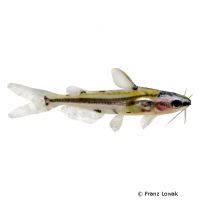Shadow Catfish (Hyalobagrus flavus)
| Shadow Catfish Hyalobagrus flavus | |
|---|---|
| Name | Shadow Catfish |
| Name Lat. | Hyalobagrus flavus |
| Family | Bagrid Catfishes |
| Family lat. | Bagridae |
| Order | Catfishes |
| Order lat. | Siluriformes |
| Origin | Sumatra, Borneo |
| Habitat | Streams |
| Diet | Carnivore |
| pH | 5.5-7.0 |
| Behavior | Peaceful |
| Keeping | Group |
| Care Level | Moderate |
| Reproduction | Egg scatterer |
| Breeding | None reported |
| Life Span | N/A |
| Protection | No |
| Metric Units | |
| Size | 3-4 cm |
| Temperature | 21-26 °C |
| Hardness | 5-12 °dH |
| Aquarium | ~ 60 l |
| US Units | |
| Size | 1.2"-1.6" |
| Temperature | 70-79 °F |
| Hardness | 89-214 ppm |
| Aquarium | ~ 15 gal |
Distribution and habitat
The dwarf spiny catfish are native to the Batang Hari catchment area in Sumatra and the Mentaya in southern Borneo. They live in flowing waters with dense underwater vegetation and roots and branches protruding into the water.
Maintenance
The aquarium should have dense planting reaching the surface, with numerous hiding places such as stones (e.g. perforated rocks), catfish tubes and roots, as well as provide sufficient swimming space. A dark, sandy-muddy substrate covered with some foliage (sea almond tree, oak), subdued light (floating plant cover) and soft, slightly acidic water as well as a weak current is ideal.
No ammonia, ammonium and nitrite should be detectable, the nitrate value should not exceed 100 mg/l. To ensure the water quality and oxygen content, a filter and heater adapted to the aquarium size is required, as well as lighting for the species-appropriate day-night rhythm of the animals.
Diet
In the wild they feed mainly on small crustaceans and insect larvae. The food supply consists of live, frozen and dry food. For a balanced diet, feed once a day with a high-quality sinking dry food for catfish (flakes, granules, pellets) as well as cyclops, daphnia, mosquito larvae, artemia and tubifex (live or frozen)
It is recommended to feed small portions several times a day. Only feed as much as will be eaten within a few minutes. Regular and varied feeding promotes health and increases resistance.
Behaviour and compatibility
They are peaceful and sociable fish that should be kept in a group of at least 5, but preferably more. They can be socialized very well with other peaceful and not too big fish. In too small groups they remain shy and skittish.
Basically, only compatible fish species with similar demands on water condition and water temperature should be socialized.
Sex dimorphism
The sexes are difficult to distinguish. The transparent, spawning females appear rounder. With some experience, the sexes can be distinguished by their genital papilla, which is longer in the male.
Reproduction and breeding
There are no known reports of successful breeding in the aquarium
Important
The foliage (sea almond tree, oak, etc.) enriches the water with humic substances and naturally lowers the pH.
When catching, use as fine-meshed nets as possible, so that the hard rays of the pectoral fins do not get caught, which can cause painful injuries when touched.
The well-being of the fish should be checked regularly. Temperature should be checked daily, pH, hardness and nitrate levels at least every 14 days. Regular partial water changes are recommended, even when contaminant levels have not yet reached the upper limit. Sudden changes in water quality should be avoided. Newly introduced fish must be accustomed slowly to the water in the aquarium.
Further literature can be found in your pet store.
References
Text: Werner Winter; Image: Franz Lowak
Source: BMELV (1998): Tierschutzgutachten - Haltung von Zierfischen (Süßwasser); ENGELMANN (2005): Zootierhaltung - Tiere in menschlicher Obhut: Fische, Verlag Harri Deutsch
- Gemäß § 21 Abs. 5 Tierschutzgesetz idgF
